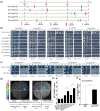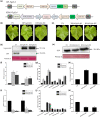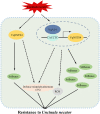Alfin-like transcription factor VqAL4 regulates a stilbene synthase to enhance powdery mildew resistance in grapevine
- PMID: 36404575
- PMCID: PMC9831286
- DOI: 10.1111/mpp.13280
Alfin-like transcription factor VqAL4 regulates a stilbene synthase to enhance powdery mildew resistance in grapevine
Abstract
Resveratrol is a phytoalexin that is synthesized by stilbene synthase (STS). Resveratrol in the human diet is known to have beneficial effects on health. We previously identified six novel STS (VqNSTS) transcripts from the transcriptome data of Vitis quinquangularis accession Danfeng-2. However, the functions of and defensive mechanisms triggered by these VqNSTS transcripts remain unknown. In the present study, we demonstrate that the expression of five of these six novel members, VqNSTS2-VqNSTS6, can be induced by the powdery mildew-causing fungus Uncinula necator. Additionally, overexpression of VqNSTS4 in the V. vinifera susceptible cultivar Thompson Seedless promoted accumulation of stilbenes and enhanced resistance to U. necator by activating salicylic acid (SA) signalling. Furthermore, our results indicate that the Alfin-like (AL) transcription factor VqAL4 can directly bind to the G-rich element (CACCTC) in the VqNSTS4 promoter and activate gene expression. Moreover, overexpression of VqAL4 in Thompson Seedless enhanced resistance to U. necator by promoting stilbene accumulation and activating SA signalling. Conversely, RNA interference-mediated silencing of VqNSTS4 and VqAL4 resulted in increased susceptibility to U. necator. Collectively, our results reveal that VqNSTS4, regulated by VqAL4, enhances grapevine resistance to powdery mildew by activating SA signalling. Our findings may be useful to improve disease resistance in perennial fruit trees.
Keywords: Chinese wild Vitis quinquangularis; VqAL4 transcription factor; VqNSTS; disease resistance; stilbene.
© 2022 The Authors. Molecular Plant Pathology published by British Society for Plant Pathology and John Wiley & Sons Ltd.
Conflict of interest statement
The authors declare they have no conflicts of interest.
Figures









Similar articles
-
VqERF1B-VqERF062-VqNSTS2 transcriptional cascade enhances stilbene biosynthesis and resistance to powdery mildew in grapevine.Plant Biotechnol J. 2025 Jun;23(6):2065-2082. doi: 10.1111/pbi.70041. Epub 2025 Mar 10. Plant Biotechnol J. 2025. PMID: 40062824 Free PMC article.
-
Expression of stilbene synthase VqSTS6 from wild Chinese Vitis quinquangularis in grapevine enhances resveratrol production and powdery mildew resistance.Planta. 2019 Dec;250(6):1997-2007. doi: 10.1007/s00425-019-03276-2. Epub 2019 Sep 17. Planta. 2019. PMID: 31531782
-
VqGT33 responds to biotic and abiotic stress and regulates VqNSTSs expression to enhance powdery mildew resistance in grapevine.Plant Sci. 2025 Oct;359:112607. doi: 10.1016/j.plantsci.2025.112607. Epub 2025 Jun 18. Plant Sci. 2025. PMID: 40553772
-
A VqMAPK4-VqGT3-VqNSTS6 module regulates powdery mildew resistance via stilbene biosynthesis in Chinese wild grapevine.Plant Physiol. 2025 Apr 30;198(1):kiaf140. doi: 10.1093/plphys/kiaf140. Plant Physiol. 2025. PMID: 40203126
-
Grapevine powdery mildew (Erysiphe necator): a fascinating system for the study of the biology, ecology and epidemiology of an obligate biotroph.Mol Plant Pathol. 2012 Jan;13(1):1-16. doi: 10.1111/j.1364-3703.2011.00728.x. Epub 2011 Jun 20. Mol Plant Pathol. 2012. PMID: 21726395 Free PMC article. Review.
Cited by
-
CRISPR/Cas9-mediated CHS2 mutation provides a new insight into resveratrol biosynthesis by causing a metabolic pathway shift from flavonoids to stilbenoids in Vitis davidii cells.Hortic Res. 2024 Oct 9;12(1):uhae268. doi: 10.1093/hr/uhae268. eCollection 2025 Jan. Hortic Res. 2024. PMID: 39802734 Free PMC article.
-
Advances in the molecular mechanism of grapevine resistance to fungal diseases.Mol Hortic. 2025 Jan 2;5(1):1. doi: 10.1186/s43897-024-00119-x. Mol Hortic. 2025. PMID: 39743511 Free PMC article. Review.
-
Comprehensive analysis of Alfin-like transcription factors associated with drought and salt stresses in wheat (Triticum aestivum L.).BMC Genomics. 2024 Jul 17;25(1):701. doi: 10.1186/s12864-024-10557-y. BMC Genomics. 2024. PMID: 39020295 Free PMC article.
-
Recent advances in improving yield and immunity through transcription factor engineering.J Integr Plant Biol. 2025 Aug;67(8):2005-2027. doi: 10.1111/jipb.13932. Epub 2025 May 21. J Integr Plant Biol. 2025. PMID: 40396540 Free PMC article. Review.
-
VqERF1B-VqERF062-VqNSTS2 transcriptional cascade enhances stilbene biosynthesis and resistance to powdery mildew in grapevine.Plant Biotechnol J. 2025 Jun;23(6):2065-2082. doi: 10.1111/pbi.70041. Epub 2025 Mar 10. Plant Biotechnol J. 2025. PMID: 40062824 Free PMC article.
References
-
- Bastola, D.R. , Pethe, V.V. & Winicov, I. (1998) Alfin1, a novel zinc‐finger protein in alfalfa roots that binds to promoter elements in the salt‐inducible MsPRP2 gene. Plant Molecular Biology, 38, 1123–1135. - PubMed
-
- Cao, J. (2012) Characterization of stilbene synthase gene and genetic transformation in grape. Master thesis. Yangling, China: Northwest A & F University.
-
- Chandrika, N.N.P. , Sundaravelpandian, K. , Yu, S.‐M. & Schmidt, W. (2013) ALFIN‐LIKE 6 is involved in root hair elongation during phosphate deficiency in Arabidopsis . New Phytologist, 198, 709–720. - PubMed
-
- Cheng, S. , Xie, X. , Xu, Y. , Zhang, C. , Wang, X. , Zhang, J. et al. (2016) Genetic transformation of a fruit‐specific, highly expressed stilbene synthase gene from Chinese wild Vitis quinquangularis . Planta, 243, 1041–1053. - PubMed
Publication types
MeSH terms
Substances
LinkOut - more resources
Full Text Sources

